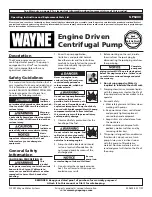
3
5
4
S1
S2
6
7
Fig. 17:
Installation location and circuit diagram
S1+S2
N.O. contact
5
O-ring
3
Oil duct cover
6
Screws
4
Flange
7
Oil pressure switch
Installing operating fluid monitoring
1. Shut down the vacuum pump and allow it to cool if necessary.
2. Vent the pump to atmospheric pressure via the intake side.
3. Remove the oil duct cover and collect the escaping operating fluid.
4. Dispose of the operating fluid according to locally applicable regulations.
5. Install the flange with O-ring and tighten the two screws to
– torque:
10 Nm
.
6. Screw the oil pressure switch with O-ring into the flange.
– torque:
6 Nm
.
7. Remove protective cap.
8. Establish the electrical connection to the pressure switch.
9. Replace the protective cap.
Order number
PK 223 720 -U
Classification
Oil pressure switch
Switching current V AC
2 A
Set point
1500 hPa
Switching voltage
250 V
For pump
Duo 35/65, Uno 35/65
Monitored Features
Operating fluid pressure
Protection category
IP55
Contact
Closing contact, normally open
Tbl. 9:
Technical data, oil pressure switch
5.6.4 Gas flushing device
For situations where gases or vapors that are corrosive or can contaminate the operating fluid need to
be pumped, we recommend that you flush the vacuum pump with inert gas in order to prolong the usa-
ble life of the operating fluid. The flushing gas device is installed via a bore in the pump cap, and the
gas is introduced into the operating fluid reservoir of the pump via a pipe. This saturates the operating
fluid with inert gas and prevents the pumped gases from dissolving in the oil. The injected gas also re-
duces the oil temperature, thus reducing the risk of corrosion.
Installation
28/66
















































